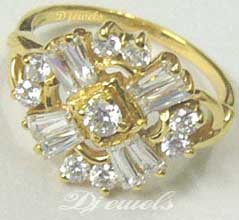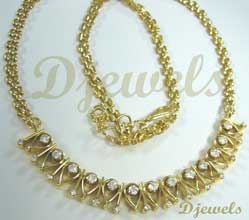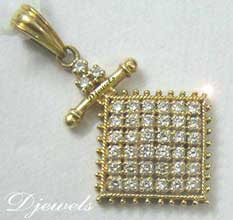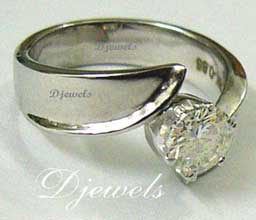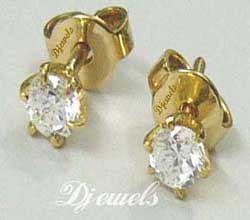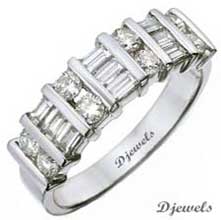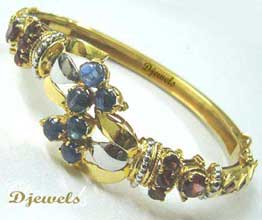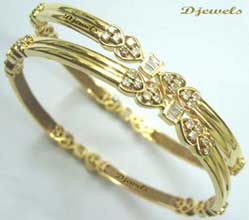Round :- This is by far the most popular diamond shape and also the most optically brilliant, because of its 360-degree symmetry. The 'ideal' round brilliant cut was calculated by gem enthusiast and mathematician Marcel Tolkowsky in 1919, to reflect and scatter the maximum amount of light. The round silhouette works with almost every mounting, from classic solitaires to the most avant-garde designs.
Oval :- This cut makes the most use of the sparkle of a round-brilliant cut, and combines this with an elongated outline which is particularly flattering on the hand. The oval cut diamond is based upon the traditional configuration of the round brilliant diamond and that's why its technical name is oval modified brilliant diamond.
Princess : - This has become particularly popular over the last few years - developed in 1970, the Princess is now second only to the round in popularity. The Princess Cut Diamond is a brilliant style shape with sharp, uncut corners. This is the perfect choice for a combination between a square or rectangular outline with the brilliance of a round cut.
Emerald :-This is considered among the most classic of diamond shapes. It is always cut with blocked corners, usually to a rectangular outline, although some are cut to be more square.
Because of its simpler faceting, larger inclusions tend to be more visible to the naked eye, so diamonds cut in this shape need to be of a higher clarity. Diamond 'purists' love the emerald cut for its simplicity.
Radiant :-The Radiant Cut Diamond is a straight-edged rectangular or square stone with cut corners. Radiant diamonds show resemblance to emerald cut diamonds with respect to shape.
The radiant cut diamond has 62-70 facets. Radiant are principally used for important center stones primarily for rings but also for pendant. They are rarely used for earrings or as side stones because they are hard to calibrate and match.
Pear :- The Pear Shaped Brilliant is a combination of a Round brilliant and a Marquise cut. Pendants looks very nice set with a Pear shape as do earrings, due to the "Teardrop" shape.
The pear shaped brilliant diamond is based upon the traditional configuration of the round brilliant diamond. More than other fancy shapes, length-to-width ratio is a matter of taste when it comes to pear shaped diamonds.
You want to more information about Shape of Diamonds pls visit:- http://www.djewels.org/diamond_tutorials.asp
Monday, December 24, 2007
Diamond Carat
A Carat is a unit of weight for diamonds and other gems. The metric carat of .200 grams, or 200 milligrams was adopted in the United States in 1913 and now standardized in the principle countries of the world.
If other factors are equal, the more a stone weighs, the more valuable it will be. Gemological laboratories measure carat weight when the diamond is loose (unmounted). While it is possible to estimate the weight of a mounted diamond, the lab uses ultrasensitive scales to achieve an exact weight, measured 3 decimal places, although the third decimal place is not usually mentioned at the retail level.
Here are several ways to express 1 carat:
1 ct.
200 milligrams
1/5 gram
100 points
4 grainer (not often used in retail environment)
The weight of a diamond is numerically expressed in carats
Diamond weight is subdivided further into smaller units commonly referred to as points. A point(s) is a scale of weight that is equal to .01 carat. A one carat diamond is made up of 100 points. The term point(s) does not refer to the amount of facets or individual flat surfaces a diamond possesses as its definition is sometimes incorrectly interpreted.
How Carat weight Affects Value
Larger diamonds are more rare and in more demand than smaller diamonds of the same quality, so they can be sold for a higher price. A one carat diamond solitaire ring is nearly always more expensive than a diamond ring made up of multiple diamonds that are similar, but smaller, even though they total one carat or more. Carat size describes the weight of a diamond. 1 carat is equivalent to 200 milligrams. A carat is then divided into 100 points. Therefore, a 50 point diamond weights 100 milligrams.
Further know about our Carat of Diamond and Diamond Jewelry Product pls. visit. http://www.djewels.org
If other factors are equal, the more a stone weighs, the more valuable it will be. Gemological laboratories measure carat weight when the diamond is loose (unmounted). While it is possible to estimate the weight of a mounted diamond, the lab uses ultrasensitive scales to achieve an exact weight, measured 3 decimal places, although the third decimal place is not usually mentioned at the retail level.
Here are several ways to express 1 carat:
1 ct.
200 milligrams
1/5 gram
100 points
4 grainer (not often used in retail environment)
The weight of a diamond is numerically expressed in carats
Diamond weight is subdivided further into smaller units commonly referred to as points. A point(s) is a scale of weight that is equal to .01 carat. A one carat diamond is made up of 100 points. The term point(s) does not refer to the amount of facets or individual flat surfaces a diamond possesses as its definition is sometimes incorrectly interpreted.
How Carat weight Affects Value
Larger diamonds are more rare and in more demand than smaller diamonds of the same quality, so they can be sold for a higher price. A one carat diamond solitaire ring is nearly always more expensive than a diamond ring made up of multiple diamonds that are similar, but smaller, even though they total one carat or more. Carat size describes the weight of a diamond. 1 carat is equivalent to 200 milligrams. A carat is then divided into 100 points. Therefore, a 50 point diamond weights 100 milligrams.
Further know about our Carat of Diamond and Diamond Jewelry Product pls. visit. http://www.djewels.org
Clarity of Diamonds
The clarity of a diamond refers to how clear, or "clean" the diamond is. The more "clean" the diamond, the higher the price. Most diamonds have "imperfections" in them. The clarity scale is a measure of the severity of those imperfections or "inclusions" as it is known in the trade.
Both of these distinguishable features together are called clarity characteristics. A clarity grade is determined by the relative absence of clarity characteristics.
The following is the GIA Diamond clarity-scale:
(FL) FLAWLESS
(IF) INTERNALLY FLAWLESS
(VVS1 and VVS2) VERY VERY SLIGHTLY INCLUDED
(VS1 and VS2) VERY SLIGHTLY INCLUDED
(SI1 and SI2) SLIGHTLY INCLUDED
The Clarity Enhancement Process :
During the clarity enhancement process we insert a microscopic amount of material into the imperfection. This material has the same optical refraction index as the diamond. When light travels from one medium to another, it either changes its course or reflects in a different direction. When light attempts to pass through a non-enhanced diamond that has a feather, the light hits the feather and reflects in a number of directions. That is why we see the feather, and the diamond doesn't appear to be clean.
Know more about Clarity of Diamond pls visit:- http://www.djewels.org/diamond_tutorials3.asp
Both of these distinguishable features together are called clarity characteristics. A clarity grade is determined by the relative absence of clarity characteristics.
The following is the GIA Diamond clarity-scale:
(FL) FLAWLESS
(IF) INTERNALLY FLAWLESS
(VVS1 and VVS2) VERY VERY SLIGHTLY INCLUDED
(VS1 and VS2) VERY SLIGHTLY INCLUDED
(SI1 and SI2) SLIGHTLY INCLUDED
The Clarity Enhancement Process :
During the clarity enhancement process we insert a microscopic amount of material into the imperfection. This material has the same optical refraction index as the diamond. When light travels from one medium to another, it either changes its course or reflects in a different direction. When light attempts to pass through a non-enhanced diamond that has a feather, the light hits the feather and reflects in a number of directions. That is why we see the feather, and the diamond doesn't appear to be clean.
Know more about Clarity of Diamond pls visit:- http://www.djewels.org/diamond_tutorials3.asp
Labels:
5c,
AGS,
brilliant cut,
carat,
clarity,
color,
cost,
cut,
diamond tutorial,
diamonds and fine jewelry,
GIA,
HRD,
ideal cut,
jewlery shopping,
lifetime warranty
Diamond Colors
Most people have never even heard of coloured diamonds. Almost all of the publicity and advertising for diamonds is slanted towards convincing consumers that white, or more accurately colourless, is the only desirable colour for diamonds, and that diamonds with a slight tinge of yellow or brown are less attractive and therefore less desirable.
About Diamond Color
The Color of a diamond refers to the tone and saturation of color, or the depth of color in a diamond. The color of a diamond can range from colorless to a yellow or brown hue. A more colorless diamond is rarer and more valuable because it appears white and brighter to the eye. The most respected system used today for evaluating diamond color was developed by the Gemological Institute of America, (GIA).
Further information Diamond Color visit this page :- http://www.djewels.org/diamondscoloured_djewels.asp
Even though there are several grades in each category, there are slight differences between the letter grades. D is the clearest and most valuable, X is a dingy yellow and least expensive. Z grade-colored diamonds are the rarest and most expensive. A diamond so saturated with nitrogen that it becomes a deep, rich yellow is as rare as a colorless diamond.
About Diamond Color
The Color of a diamond refers to the tone and saturation of color, or the depth of color in a diamond. The color of a diamond can range from colorless to a yellow or brown hue. A more colorless diamond is rarer and more valuable because it appears white and brighter to the eye. The most respected system used today for evaluating diamond color was developed by the Gemological Institute of America, (GIA).
Further information Diamond Color visit this page :- http://www.djewels.org/diamondscoloured_djewels.asp
Even though there are several grades in each category, there are slight differences between the letter grades. D is the clearest and most valuable, X is a dingy yellow and least expensive. Z grade-colored diamonds are the rarest and most expensive. A diamond so saturated with nitrogen that it becomes a deep, rich yellow is as rare as a colorless diamond.
Labels:
AGS,
brilliant cut,
carat,
clarity,
color,
cut,
diamond education,
Diamond jewelry,
GIA,
HRD,
ideal cut,
lifetime warranty
Diamond Cut
Cut height is the most important factor in a diamond's brilliance. Since it's all about light optics and the ideal angles to produce the maximum effect the cut is critical to the beauty of the diamond.
The Cut of a Diamond is the only property which is totally dependent on man. Although often overlooked, cut is actually one of the most important aspects to consider when choosing your diamond. A Diamond cutter analyzes the rough diamond, and has to determine how to extract the most beauty and most profit out of the rough stone.
The Round Brilliant :- Cut is designed to provide maximum optics for the brilliance and scintillation, making the light seem to sparkle and dance in the light.
The most common, and most "brilliant", diamond cut is the Brilliant Cut, a.k.a. the Round Cut, American Ideal Cut, or American Standard Cut.
The Marquise Cut :- Looks something like a football, when viewed straight down from the top. Some Marquise are cut too thin and suffer from a markedly dark center (commonly called the bow tie effect). This effect is eliminated by paying attention to the depth (want lower sixties) and the crown height (want close to 14%) The light passes through the back of the stone due to the criticality of the angles needed to reflect the stone being too steep.
Oval Cut :- Has an elliptical shape when viewed from the top.
For both the Oval, the ratio of the length to the width should be about 1.5:1. If it is much greater then that you will see a dark area. This is commonly called a bow tie effect, "undesirable". If the ratio is much less then 1.5:1, the stone looks like a misshapen round.
Pear Shape Cut :- The pear is another popular fancy cut it uses the base of a brilliant or round cut and extends it self to point , if well proportioned it gives a depth of scintillation to the point of the stone. A benefit in design if a longer look is required.
Emerald Cut :- The Ideal Emerald cut features additional extra facets strategically placed to dramatically improve light return and optical symmetry. This Emerald Cut Diamond retains the elegance of the traditional Emerald cut with dramatically improved brilliance.
You want more information about Diamond cut pls:- http://www.djewels.org/diamond_tutorials1.asp
The Cut of a Diamond is the only property which is totally dependent on man. Although often overlooked, cut is actually one of the most important aspects to consider when choosing your diamond. A Diamond cutter analyzes the rough diamond, and has to determine how to extract the most beauty and most profit out of the rough stone.
The Round Brilliant :- Cut is designed to provide maximum optics for the brilliance and scintillation, making the light seem to sparkle and dance in the light.
The most common, and most "brilliant", diamond cut is the Brilliant Cut, a.k.a. the Round Cut, American Ideal Cut, or American Standard Cut.
The Marquise Cut :- Looks something like a football, when viewed straight down from the top. Some Marquise are cut too thin and suffer from a markedly dark center (commonly called the bow tie effect). This effect is eliminated by paying attention to the depth (want lower sixties) and the crown height (want close to 14%) The light passes through the back of the stone due to the criticality of the angles needed to reflect the stone being too steep.
Oval Cut :- Has an elliptical shape when viewed from the top.
For both the Oval, the ratio of the length to the width should be about 1.5:1. If it is much greater then that you will see a dark area. This is commonly called a bow tie effect, "undesirable". If the ratio is much less then 1.5:1, the stone looks like a misshapen round.
Pear Shape Cut :- The pear is another popular fancy cut it uses the base of a brilliant or round cut and extends it self to point , if well proportioned it gives a depth of scintillation to the point of the stone. A benefit in design if a longer look is required.
Emerald Cut :- The Ideal Emerald cut features additional extra facets strategically placed to dramatically improve light return and optical symmetry. This Emerald Cut Diamond retains the elegance of the traditional Emerald cut with dramatically improved brilliance.
You want more information about Diamond cut pls:- http://www.djewels.org/diamond_tutorials1.asp
Sunday, December 23, 2007
The 5Cs and things to know about Diamonds
The 5Cs and things to know about Diamonds
Diamond
Diamond is the hardest known natural material and the third-hardest known material after aggregated diamond nanorods and ultrahigh frequency. Its hardness and high dispersion of light make it useful for industrial applications and jewelry.
Cut :- Cut really is the craftsmanship applied in cutting the facets od Diamonds. Cut of a Diamond refflects light and responsible for the gem's brillance, sparkle, beauty and value. The Cut of a Diamond refers not only to the quality of the cut, but also to the shape of the diamond and the number of its facets. A well cut diamond regardless of its shape, sparkles, has more fire and offers the greatest brilliance and called "Brilliant Cut".
Color :- Color is the natural body-color visible in a diamond and is the one C deatermined completely by nature, not man. As,rule, the closer a diamond is to colorless, the more valuable and beauti ful it is, the diamond color grading scale uses the letters of the alphabet, beginning at "D" (colorless) and going to Z.
Clarity :- Clarity is an indication of a diamond's purity. Experts grade a diamond's clarity on the number, size, type and location of inclusions and blemishes. A diamond with greater clarity will have greater brilliance and value.
Carat :- A diamond's size is measured in carat weight means carat is a unit of measurement for diamond. Diamond prices tend to rise exponentially with carat weigh. Each carat is equal to 200 Milligrams and divided in 100 Cents.
Cost :- the one of the most significant part of today's 4 C's Diamond world is cost. If someone is unable to get the diamond at best price it is worthless to buy. This cost factor makes the 5th C about the Diamond.
For more information about 5C's Diamonds please visit this page: http://www.djewels.org/diamond_tutorials.asp
Diamond
Diamond is the hardest known natural material and the third-hardest known material after aggregated diamond nanorods and ultrahigh frequency. Its hardness and high dispersion of light make it useful for industrial applications and jewelry.
Cut :- Cut really is the craftsmanship applied in cutting the facets od Diamonds. Cut of a Diamond refflects light and responsible for the gem's brillance, sparkle, beauty and value. The Cut of a Diamond refers not only to the quality of the cut, but also to the shape of the diamond and the number of its facets. A well cut diamond regardless of its shape, sparkles, has more fire and offers the greatest brilliance and called "Brilliant Cut".
Color :- Color is the natural body-color visible in a diamond and is the one C deatermined completely by nature, not man. As,rule, the closer a diamond is to colorless, the more valuable and beauti ful it is, the diamond color grading scale uses the letters of the alphabet, beginning at "D" (colorless) and going to Z.
Clarity :- Clarity is an indication of a diamond's purity. Experts grade a diamond's clarity on the number, size, type and location of inclusions and blemishes. A diamond with greater clarity will have greater brilliance and value.
Carat :- A diamond's size is measured in carat weight means carat is a unit of measurement for diamond. Diamond prices tend to rise exponentially with carat weigh. Each carat is equal to 200 Milligrams and divided in 100 Cents.
Cost :- the one of the most significant part of today's 4 C's Diamond world is cost. If someone is unable to get the diamond at best price it is worthless to buy. This cost factor makes the 5th C about the Diamond.
For more information about 5C's Diamonds please visit this page: http://www.djewels.org/diamond_tutorials.asp
Labels:
AGS,
brilliant cut,
carat,
clarity,
color,
cost,
diamond tutorial,
GIA,
HRD,
ideal cut,
Know about Diamonds
Know about Diamonds
Diamond is the hardest known natural material and the third-hardest known material after aggregated diamond nanorods and ultrahigh frequency. Its hardness and high dispersion of light make it useful for industrial applications and jewelry.
Subscribe to:
Posts (Atom)
.jpg)

